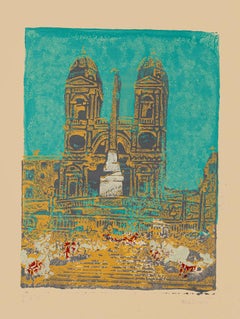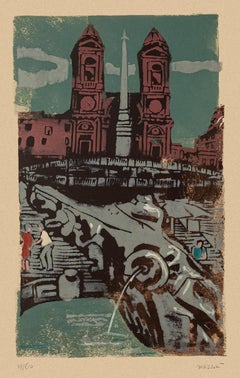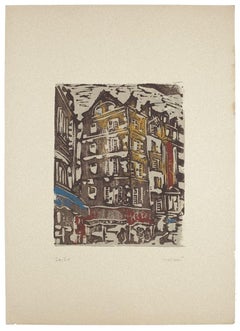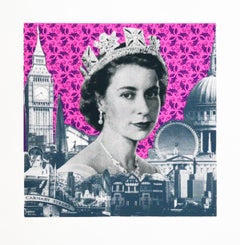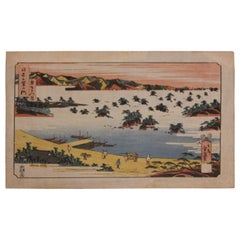Carlo Mazzoni Art
to
4
3
1
2
1
1
Overall Height
to
Overall Width
to
1
2
2
1
1
1
1
4
1
4
6,958
3,340
2,513
1,213
3
2
1
Artist: Carlo Mazzoni
Trinità dei Monti - Original Screen Print by Carlo Mazzoni - Late 20th Century
By Carlo Mazzoni
Located in Roma, IT
Trinità dei Monti is an original screen print realized by Carlo Mazzoni.
Hand-signed by the artist in pencil on the lower right corner.
Artist's proof.
Good conditions.
This art...
Category
Late 20th Century Carlo Mazzoni Art
Materials
Screen, Paper
Trinità dei Monti - Original Screen Print by Carlo Mazzoni - Late 20th Century
By Carlo Mazzoni
Located in Roma, IT
Trinità dei Monti is an original screen print realized by Carlo Mazzoni.
Hand-signed by the artist in pencil on the lower right corner.
Edition 19/60
Good conditions.
This artwo...
Category
Late 20th Century Carlo Mazzoni Art
Materials
Screen, Paper
Navona Square - Screen Print by Carlo Mazzoni - Late 20th Century
By Carlo Mazzoni
Located in Roma, IT
Navona Square - Rome is an original serigraph realized by Carlo Mazzoni (1922).
Hand-signed by the artist in pencil on the lower right corner. Numbered on the lower-left corner. Edi...
Category
Late 20th Century Modern Carlo Mazzoni Art
Materials
Screen
Houses - Woodcut by Carlo Mazzoni - 1977
By Carlo Mazzoni
Located in Roma, IT
Houses in the city is an original woodcut realized by Carlo Mazzoni.
Hand-signed by the artist in pencil on the lower right corner. Numbered on the lower-left corner. Edition 24/60....
Category
1970s Carlo Mazzoni Art
Materials
Woodcut
Related Items
Crowing Glory, Anne Storno, Pop art, Limited edition print for sale, The Queen
By Anne Storno
Located in Deddington, GB
Crowning glory by Anne Storno
Hand printed, limited edition screen print.
Sold unframed
Image size: H:30cm x W:30cm
Complete size of unframed work: H:30cm x W:30cm x D:0.1cm
Please note that insitu images are purely an indication of how a piece may look
Created from a hand made paper collage and spray painting mixed media work that has been transformed into a screen print.Queen Elizabeth is surrounded by famous London’s place : St Paul’s Cathedral, Big Ben, London Bridge, London Eye, Carnaby Street and also David Bowie’s portrait...
Category
21st Century and Contemporary Pop Art Carlo Mazzoni Art
Materials
Paper, Screen
H 11.82 in W 11.82 in D 0.04 in
Edo Landscape Japanese Woodblock Print
By Utagawa Hiroshige (Ando Hiroshige)
Located in Houston, TX
Edo Meisho woodblock print of a famous Japanese coastal dock. This woodblock is most likely apart of the series "One Hundred Famous Views of Edo." The woodblock print is printed on r...
Category
1850s Edo Carlo Mazzoni Art
Materials
Woodcut
H 10 in W 15 in D 0.004 in
Jonah
By Sadao Watanabe
Located in Santa Monica, CA
SADAO WATANABE (Japanese 1913-1996)
JONAH, 1959
Color stencil, signed, numbered and dated in white ink. Sheet, 25 5/8 x 22 5/8 inches. Edition: 44/50. Good color and generally good ...
Category
1950s Modern Carlo Mazzoni Art
Materials
Stencil, Woodcut
Saruwaka-machi District and Kinryûzan Temple Seen from Matsuchiyama
By Utagawa Hiroshige (Ando Hiroshige)
Located in Houston, TX
Three women in the Saruwaka-machi District with a view of Kinryûzan Temple seen from the famous landmark Matsuchiyama. The woodblock print is from the series "Famous Places in Edo". ...
Category
1850s Edo Carlo Mazzoni Art
Materials
Woodcut
H 9.5 in W 14 in D 0.004 in
Beauties on the Beach with view of Mount Fuji
By Yoshu Chikanobu
Located in Burbank, CA
Shichirigahama, Sagami Province. A beauty in the foreground waves to her young companions, who run towards her on the beach. The beauty at left wears a western-style golden ring. We ...
Category
1890s Edo Carlo Mazzoni Art
Materials
Mulberry Paper, Handmade Paper, Woodcut
Rare 1923 Cubist Reuven Rubin Woodcut Woodblock Kabbalah Print Israeli Judaica
By Reuven Rubin
Located in Surfside, FL
This is from the original first edition 1923 printing. there was a much later edition done after these originals.
These are individually hand signed in pencil by artist as issued.
This listing is for the one print. the other documentation is included here for provenance and is not included in this listing.
The various images inspired by the Jewish Mysticism and rabbis and mystics of jerusalem and Kabbalah is holy, dramatic and optimistic Rubin succeeded to evoke the spirit of life in Israel in those early days.
They are done in a modern art style influenced by German Expressionism, particularly, Ernst Barlach, Ernst Ludwig Kirchner, and Franz Marc, as introduced to Israel by Jakob Steinhardt, Hermann Struck and Joseph Budko.
Reuven Rubin 1893 -1974 was a Romanian-born Israeli painter and Israel's first ambassador to Romania.
Rubin Zelicovich (later Reuven Rubin) was born in Galati to a poor Romanian Jewish Hasidic family. He was the eighth of 13 children. In 1912, he left for Ottoman-ruled Palestine to study art at Bezalel Academy of Art and Design in Jerusalem. Finding himself at odds with the artistic views of the Academy's teachers, he left for Paris, France, in 1913 to pursue his studies at the École Nationale Supérieure des Beaux-Arts. He was of the well known Jewish artists in Paris along with Marc Chagall and Chaim Soutine,
At the outbreak of World War I, he was returned to Romania, where he spent the war years.
In 1921, he traveled to the United States with his friend and fellow artist, Arthur Kolnik. In New York City, the two met artist Alfred Stieglitz, who was instrumental in organizing their first American show at the Anderson Gallery. Following the exhibition, in 1922, they both returned to Europe. In 1923, Rubin emigrated to Mandate Palestine.
Rubin met his wife, Esther, in 1928, aboard a passenger ship to Palestine on his return from a show in New York. She was a Bronx girl who had won a trip to Palestine in a Young Judaea competition. He died in 1974.
Part of the early generation of artists in Israel, Joseph Zaritsky, Arieh Lubin, Reuven Rubin, Sionah Tagger, Pinchas Litvinovsky, Mordecai Ardon, Yitzhak Katz, and Baruch Agadati; These painters depicted the country’s landscapes in the 1920s rebelled against the Bezalel school of Boris Schatz. They sought current styles in Europe that would help portray their own country’s landscape, in keeping with the spirit of the time. Rubin’s Cezannesque landscapes from the 1920s were defined by both a modern and a naive style, portraying the landscape and inhabitants of Israel in a sensitive fashion. His landscape paintings in particular paid special detail to a spiritual, translucent light. His early work bore the influences of Futurism, Vorticism, Cubism and Surrealism.
In Palestine, he became one of the founders of the new Eretz-Yisrael style. Recurring themes in his work were the bible, the prophet, the biblical landscape, folklore and folk art, people, including Yemenite, Hasidic Jews and Arabs. Many of his paintings are sun-bathed depictions of Jerusalem and the Galilee. Rubin might have been influenced by the work of Henri Rousseau whose naice style combined with Eastern nuances, as well as with the neo-Byzantine art to which Rubin had been exposed in his native Romania. In accordance with his integrative style, he signed his works with his first name in Hebrew and his surname in Roman letters.
In 1924, he was the first artist to hold a solo exhibition at the Tower of David, in Jerusalem (later exhibited in Tel Aviv at Gymnasia Herzliya). That year he was elected chairman of the Association of Painters and Sculptors of Palestine. From the 1930s onwards, Rubin designed backdrops for Habima Theater, the Ohel Theater and other theaters.
His biography, published in 1969, is titled My Life - My Art. He died in Tel Aviv in October 1974, after having bequeathed his home on 14 Bialik Street and a core collection of his paintings to the city of Tel Aviv. The Rubin Museum opened in 1983. The director and curator of the museum is his daughter-in-law, Carmela Rubin. Rubin's paintings are now increasingly sought after. At a Sotheby's auction in New York in 2007, his work accounted for six of the ten top lots. Along with Yaacov Agam and Menashe Kadishman he is among Israel's best known artists internationally. Education
1912 Bezalel Academy of Arts and Design, Jerusalem
1913-14 École des Beaux Arts, Paris and Académie Colarossi, Paris
Select Group Exhibitions
Eged - Palestine Painters Group Eged - Palestine Painters Group, Allenby Street, Tel Aviv 1929
Artists: Chana Orloff, Abraham Melnikoff, Rubin, Reuven Nahum Gutman, Sionah Tagger,Arieh Allweil,
Jewish Artists Association, Levant Fair, Tel Aviv, 1929
Artists: Ludwig Blum,Eliyahu Sigad, Shmuel Ovadyahu, Itzhak Frenel Frenkel,Ozer Shabat, Menahem Shemi...
Category
1920s Abstract Carlo Mazzoni Art
Materials
Woodcut
Original "Wagon Lits" pop art style serigraph travel by train poster
By Valerio Adami
Located in Spokane, WA
Original “Wagon Lits” serigraph poster by the artist Valerio Adami.
It was printed in France by GrafiCaza (Michel Caza), one of the finest serigraph companies on woven paper—in exce...
Category
1990s American Modern Carlo Mazzoni Art
Materials
Screen
H 36 in W 24 in D 0.05 in
Once upon a time in London, Night, Vincent Van Gogh, Big Ben, Dog, Night Walk
By Mychael Barratt
Located in Deddington, GB
A limited edition woodcut on paper print by Mychael Barratt of Vincent Van Gogh on a night walk though London, as blue, turquoise and browns outline Big Ben and the Parliament in the distance.
Additional information:
Mychael Barratt
Once upon a time in London, Night [2023]
Woodcut on paper
Signed and titled in pencil
Numbered from the edition of 100
Please note that insitu images are purely an indication of how a piece may look
Please note sheet sizes may differ.
Image size:
Height: 28cm
Width: 28cm
Complete size of sheet:
Height: 39.5cm
Width: 38.2cm
Depth: 0.1cm
ARTIST BIO:
Mychael Barratt was born in Toronto, Canada, however, considers himself to be a Londoner since arriving for what was supposed to be a two-week stay thirty years ago. He is a narrative artist whose work is steeped in imagery relating to art history, literature, theatre and everything else that overfills his bookshelves. He was an artist in residence for Shakespeare’s Globe Theatre...
Category
2010s Contemporary Carlo Mazzoni Art
Materials
Paper, Woodcut
H 15.56 in W 15.04 in D 0.04 in
'Serving Poi', Hawaii, NYMoMA, Metropolitan Museum, National Gallery, SFAA, GGIE
By Marion Osborn Cunningham
Located in Santa Cruz, CA
Stamped, verso, with certification of authenticity for 'Marion Cunningham' (American, 1908-1948) and created in 1948.
Paper dimensions: 17.75 x 16 inches
A substantial and rare, mid-century silkscreen showing a Hawaiian family seated beneath a traditional tent of tapa cloth and being served poi by a young woman. To realize this complex work, Cunningham used as many as one dozen hand-drawn screens, each of which varied in pigment, hue and opacity. Created during the extraordinary creative ferment that characterized the last year of the artist's life, this work represents a remarkable achievement for both artist and medium.
Born in Indiana, Marion Osborn Cunningham moved to California in 1911. She first studied art with the American Impressionist, Ruth Heil Emerson, before continuing her education at Santa Barbara City College and receiving her Bachelor of Arts from Stanford University. She subsequently furthered her studies at the California School of the Fine Arts and at the Art Students League in New York City, where she met and married the American abstract artist Ben Cunningham. Returning to San Francisco...
Category
1940s Modern Carlo Mazzoni Art
Materials
Screen, Paper
Underfall N0.1 by Simon Tozer, Limited edition print, Illustrative art
Located in Deddington, GB
Underfall N0.1 by Simon Tozer [2019]
limited_edition and hand signed by the artist
Screen print on paper
Edition number 30
Image size: H:28 cm x W:30 cm
Complete Size of Unframed Wo...
Category
21st Century and Contemporary Contemporary Carlo Mazzoni Art
Materials
Paper, Screen
H 13.78 in W 15.36 in D 0.04 in
Modernist Silkscreen Screenprint 'El Station, Interior' NYC Subway, WPA Artist
By Anthony Velonis
Located in Surfside, FL
screenprint printed in color ink on wove paper. New York City subway station interior.
Anthony Velonis (1911 – 1997) was an American painter and designer born in New York City who helped introduce the public to silkscreen printing in the early 20th century.
While employed under the federal Works Progress Administration, WPA during the Great Depression, Velonis brought the use of silkscreen printing as a fine art form, referred to as the "serigraph," into the mainstream. By his own request, he was not publicly credited for coining the term.
He experimented and mastered techniques to print on a wide variety of materials, such as glass, plastics, and metal, thereby expanding the field. In the mid to late 20th century, the silkscreen technique became popular among other artists such as Robert Rauschenberg and Andy Warhol.
Velonis was born into a relatively poor background of a Greek immigrant family and grew up in the tenements of New York City. Early on, he took creative inspiration from figures in his life such as his grandfather, an immigrant from the mountains in Greece, who was "an ecclesiastical painter, on Byzantine style." Velonis attended James Monroe High School in The Bronx, where he took on minor artistic roles such as the illustration of his high school yearbook. He eventually received a scholarship to the NYU College of Fine Arts, into which he was both surprised and ecstatic to have been admitted. Around this time he took to painting, watercolor, and sculpture, as well as various other art forms, hoping to find a niche that fit. He attended NYU until 1929, when the Great Depression started in the United States after the stock market crash.
Around the year 1932, Velonis became interested in silk screen, together with fellow artist Fritz Brosius, and decided to investigate the practice. Working in his brother's sign shop, Velonis was able to master the silkscreen process. He reminisced in an interview three decades later that doing so was "plenty of fun," and that a lot of technology can be discovered through hard work, more so if it is worked on "little by little."
Velonis was hired by Mayor LaGuardia in 1934 to promote the work of New York's city government via posters publicizing city projects. One such project required him to go on a commercial fishing trip to locations including New Bedford and Nantucket for a fortnight, where he primarily took photographs and notes, and made sketches. Afterward, for a period of roughly six months, he was occupied with creating paintings from these records. During this trip, Velonis developed true respect and affinity for the fishermen with whom he traveled, "the relatively uneducated person," in his words.
Following this, Velonis began work with the Public Works of Art Project (PWAP), an offshoot of the Civil Works Administration (CWA), where he was assigned to serve the different city departments of New York. After the formation of the federal Works Progress Administration, which hired artists and sponsored projects in the arts, he also worked in theater.
Velonis began working for the federal WPA in 1935. He kept this position until 1936 or 1938, at which point he began working in the graphic art division of the Federal Art Project, which he ultimately led. Under various elements of the WPA program, many young artists, writers and actors gained employment that helped them survive during the Depression, as well as contributing works that created an artistic legacy for the country.
When interviewed in December 1994 by the Library of Congress about his time in the WPA, Velonis reflected that he had greatly enjoyed that period, saying that he liked the "excitement" and "meeting all the other artists with different points of view." He also said in a later interview that "the contact and the dialogue with all those artists and the work that took place was just invaluable." Among the young artists he hired was Edmond Casarella, who later developed an innovative technique using layered cardboard for woodcuts.
Velonis introduced silkscreen printing to the Poster Division of the WPA. As he recalled in a 1965 interview: "I suggested that the Poster division would be a lot more productive and useful if they had an auxiliary screen printing project that worked along with them. And apparently this was very favorably received..."
As a member of the Federal Art Project, a subdivision of the WPA, Velonis later approached the Public Use of Arts Committee (PUAC) for help in "propagandizing for art in the parks, in the subways, et cetera." Since the Federal Art Project could not be "self-promoting," an outside organization was required to advertise their art more extensively. During his employment with the Federal Art Project, Velonis created nine silkscreen posters for the federal government.
Around 1937-1939 Velonis wrote a pamphlet titled "Technical Problems of the Artist: Technique of the Silkscreen Process," which was distributed to art centers run by the WPA around the country. It was considered very influential in encouraging artists to try this relatively inexpensive technique and stimulated printmaking across the country.
In 1939, Velonis founded the Creative Printmakers Group, along with three others, including Hyman Warsager. They printed both their own works and those of other artists in their facility. This was considered the most important silkscreen shop of the period.
The next year, Velonis founded the National Serigraph Society. It started out with relatively small commercial projects, such as "rather fancy" Christmas cards that were sold to many of the upscale Fifth Avenue shops...
Category
1980s American Modern Carlo Mazzoni Art
Materials
Screen
Greta 3, Simon Tozer, Limited edition print, Screen Print, Sailing art
Located in Deddington, GB
Greta 3 by Simon Tozer
Limited edition print and hand signed by the artist
Edition of 40
Screen Print on Fabriano Rosaspina paper
Image size: H:71cm x W:4...
Category
21st Century and Contemporary Contemporary Carlo Mazzoni Art
Materials
Paper, Screen
H 27.96 in W 16.54 in D 0.04 in
Carlo Mazzoni art for sale on 1stDibs.
Find a wide variety of authentic Carlo Mazzoni art available for sale on 1stDibs. You can also browse by medium to find art by Carlo Mazzoni in screen print, paper, woodcut print and more. Much of the original work by this artist or collective was created during the 20th century and is mostly associated with the modern style. Not every interior allows for large Carlo Mazzoni art, so small editions measuring 11 inches across are available. Customers who are interested in this artist might also find the work of Bruno Conte, Eugene Corneau, and Mario Logli. Carlo Mazzoni art prices can differ depending upon medium, time period and other attributes. On 1stDibs, the price for these items starts at $222 and tops out at $290, while the average work can sell for $273.
